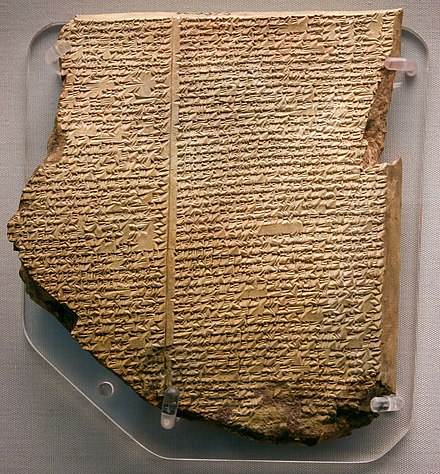
An ancient Sumerian tale—probably the most important masterpieces of the ancient literature after the Bible—of a legendary king called Gilgamesh that has found its way into discussions of the Noahic flood because the legend ends with a flood story and, thus, suggesting to some scholars at one time that the book of Genesis may share in, or perhaps was even dependant on, a common pool of ancient literary resources (which also includes Atrahasis Epic). The Epic of Gilgamesh has played an increasing important role in the modern scholarship of Genesis, where it is seen—sometime inordinately—as reflecting the background and religious context for many of the ideas in the early chapters of the book.

Tablet XI of the Epic of Gilgamesh in the British Museum. 7th Cent BC.
Gilgamesh appears to have been one of the greatest heroes of ancient Near Eastern literature, and stories about him—of which there are several versions—may have been based on a historical figure of the same name who ruled Uruk about 2700-2600 BC. The Epic of Gilgamesh tells of this tyrant-king whose oppression drove his people to cry out to their gods for relief. Through a series of adventure and encounters—of fighting them, befriending them, avenged by them, including the killing of the Bull of Heaven and the seach for Utnapishti the hero of a great deluge sent by the gods who supposed held the key to immortality—Gilgamesh is forced to reflect on his own immortality, ending his life with the only certainty that no matter what they have done in life, only death awaits him.
Not un-naturally the epic has sparked various interpretations of what really was its message. One thing, however, is certain. Whatever the initial excitement about the flood story reported in the Epic and its relation to Noah's flood, it is now clear that they tell very different stories and to different purposes, so that claims about the Bible borrowing from Babylonians have proven unsustainable.
The recovery of the ancient epic began in mid-19th Cent when Austen Henry Layard arrived in Mosul where he became interested in the ruins of Nineveh on the other side of Tigris. He began exacavating the city and soon uncovered the remains of a monumental palace of Sennacherib as well as vast trove of cuneiform clay tablets. These were brought back to the London Museum. First employed in 1866 to sort out and make sense of the 20,000 or so tablets (and others bought later), George Adam eventually learned to read them and in December 1872, gave a lecture made known the existence of the Epic for the first time in modern times. The first translation of the Epic into English in 1912.
A heart-breaking story also attends the story of the Epic of Gilgamesh. A "Christian" company called Hobby Lobby was caught (July 2021) smuggling into the US a black-market tablet of the Epic and thousands of other Iraqi artifacts supposedly for the Washington, DC, Museum of the Bible, and using false declarations to bypass the proper legal channels. The relics were finally forfeitred by the US government, and eventually repatriated to Iraq. We shall leave this story without comments, though hoping we all understand its significance. (For more, see Smithsonian Magazine, July 29, 2021.)

Media Resources>:
Andrew George, "The Epic of Gilgamesh." Lecture delivered at the Harvard Museum of the Ancient Near East, Jan 31, 2017. 1.28.45 hr. This is a lecture worth the time spent by someone recognized as the greatest authority on the subject today. The lecture by George itself is only one hour. But the additional reflections by the various scholars place the lecture within a larger, and rather useful, context.
Youtube N (Open on Phone)

Further Reading:
Stephanie Dalley, Myths from Mesopotamia. Oxford: Oxford University Press, 1989.
David Damrosch, The Buried Book: The Loss and Rediscovery of the Great Epic of Gilgamesh. New York: Henry Holt, 2006.
A. R. George, The Babylonian Gilgamesh Epic: Introduction, Critical Edition and Cuneiform Texts. Oxford: Oxford University Press, 2003.
W. G. Lambert, Babylonian Creation Myths. Winona Lake, IN: Eisenbrauns, 2013.
Kenton Sparks, Ancient Texts for the Study of the Hebrew Bible: A Guide to the Background Literature. Peabody, MA: Hendrickson, 2005.
Jeffrey Tigay, The Evolution of the Gilgamesh Epic. Philadelphia: University of Pennsylvania Press, 1982.
John Walton, Ancient Near Eastern Thought and the Old Testament: Introducing the Conceptual World of the Hebrew Bible. Grand Rapids: Baker Academic, 2006.
John Walton, The Lost World of Adam and Eve: Genesis 2-3 and the Human Origins Debate. Downers Grove: IVP Academic, 2015.

©ALBERITH
180918lch